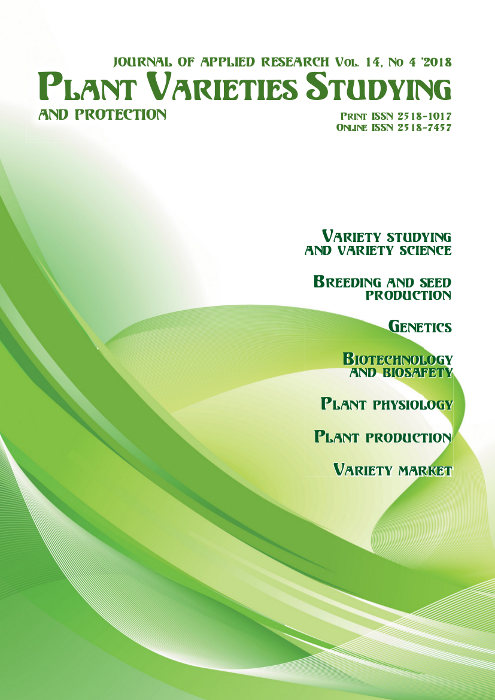The features of biochemical composition of <i>Aсtinidia arguta</i> seeds
DOI:
https://doi.org/10.21498/2518-1017.14.4.2018.151903Keywords:
Aсtinidia arguta, seeds, lipid complex, amino acids, macro- and microelementsAbstract
Рurpose. The determination of the quantitative and qualitative content of higher fatty acids, aminoacids, macro- and migroelements in Actinidia arguta (Siebold et Zucc.) Planch. ex Miq) seeds.
Methods. The qualitative and quantitative composition of higher fatty acids (HFA) was determined on a chromatograph “HP-6890”. The standard set of HFA was used to identify them. The quantitative and qualitative content of aminoacids in actinidia seeds was determined by ion exchange liquid-column chromatography method with an automatic aminoacid analyzer T339 (Czech Republic). The investigation of seeds mineral composition of was carried out using an “ELVAX-MET” X-ray fluorescence analyzer.
Results. The content of biological active compounds of A. arguta seeds of ‘Kyivska krupnoplidna’ cultivar was determined. It was revealed that actinidia seeds contain a significant amount of fatty oils (34.9±0.55% based on dry weight). Almost 90% of the total fatty acid content is unsaturated fatty acids – linolenic (64.55%), linoleic (9.96%) and oleic (15.4%). The qualitative composition of the aminoacids of actinidia seeds is represented by 19 compounds (7 essential: valine, leucine, isoleucine, threonine, lysine, methionine, phenylalanine and 12 replaceable) with a total content of 15731 mg/100 g of dry weight. The highest content among the replaceable amino acids was determined for monoamino-dicarboxylic acids-aspartic and glutamic with a content of respectively 2060 mg/100 g and 424 mg/100 g. As a result of the study of the elemental composition of actinidia seeds by the X-ray fluorescence method 14 macro- and microelements were found, the main of which are potassium, calcium, sulfur, iron and zinc.
Conclusions. The A. arguta seeds are a valuable source of biologically active substances and may be considered as a promising raw material for the creation of therapeutic and prophylactic products and phytopreparations in the pharmaceutical, food and perfume industry
Downloads
References
Ferguson, A. R., & Huang, H. (2007). Genetic resources of kiwifruit: domestication and breeding. Hort. Rev., 33, 1–121. doi: 10.1002/9780470168011.ch1
Skrypchenko, N., & Latocha, P. (2017). The genesis and current state of Actinidia collection in M. M. Grishko National botanical garden in Ukraine. Polish J. Nat. Sci., 32(3), 513–525.
Jin, D. E., Park, S. K., Park, C. H., Seung, T. W., Choi, S. G., & Heo, H. J. (2015). Nutritional components of Korean traditional actinidia (Actinidia arguta) sprout and in vitro antioxidant effect. Korean J. Food Sci. Technol., 47(1), 37–43. doi: 10.9721/kjfst.2015.47.1.37
Latocha, P. (2017). The Nutritional and Health Benefits of Kiwiberry (Actinidia arguta) – a Review. Plant Foods Hum. Nutr., 72(4), 325–334. doi: 10.1007/s11130-017-0637-y
Kolbasina, E. I., Solov’eva, L. V., Tul’nova, N. N., Kozak, N. V., Skripchenko, N. V., Moroz, P. A., … Gvozdetskaya, A. I. (2008). Kul’turnaya flora Rossii: Aktinidiya. Limonnik [Cultured flora of Russia: Actinidia. Schisandra]. Moscow: Rossel’khozakademiya. [in Russian]
Li-Li, Z., Zhen-Yu, W., Zi-Luan, F., Shuang-Qi, T., & Jia-Ren, L. (2012). Evaluation of Antioxidant and Antiproliferative Properties of Three Actinidia (Actinidia kolomikta, Actinidia arguta, Actinidia chinensis) Extracts in Vitro. Int. J. Mol. Sci., 13(5), 5506–5518. doi: 10.3390/ijms13055506
Ha, J. S., Jin, D. E., Park, S. K., Park, C. H., Seung, T. W., Bae, D. W., …Heo, H. J. (2015). Antiamnesic Effect of Actinidia arguta Extract Intake in a Mouse Model of TMT-Induced Learning and Memory Dysfunction. Evid. Based. Complement. Alternat. Med., 2015, Art. ID 876484. doi: 10.1155/2015/876484
Coelho, R., Kanda, L. R. S., Hamerski, F., Masson, M. L., & Corazza, M. L. (2015). Extraction of kiwifruit seed (Actinidia deliciosa) oil using compressed propane. J. Food Proc. Eng., 39(4), 335–344. doi: 10.1111/jfpe.12225
Honchar, O. M. (Ed.). (2000). Methods of determining of the quality indices of crop production. In Metodyka derzhavnoho sortovyprobuvannia silskohospodarskykh kultur [The method of state variety testing of agricultural crops] (Vol. 7, pp. 96–112). Kyiv: Alefa. [in Ukrainian]
Kozarenko, T. D. (1975). Ionoobmennaya khromatografiya aminokislot [Ion exchange chromatography of amino-acids]. Novosibirsk: Nauka. [in Russian]
Loginov, Yu. I. (Ed.). (1983). Metodicheskie ukazaniya po provedeniyu energodispersionnogo rentgenofluorestsentnogo analiza rastitel’nykh materialov [Guidelines for the energy-dispersive X-ray fluorescence analysis of plant materials]. Moscow: Kolos. [in Russian]
Zhu, X., & Galili, G. (2004). Lysine metabolism is concurrently regulated by synthesis and catabolism in both reproductive and vegetative tissues. Plant Physiol., 135(1), 129–136. doi: 10.1104/pp.103.037168
Böger, R. H., & Bode-Böger, S. M. (2001). The clinical pharmacology of L-arginine. Annu. Rev. Pharmacol. Toxicol., 41(1), 79–99. doi: 10.1146/annurev.pharmtox.41.1.79
Downloads
Published
How to Cite
Issue
Section
License
Copyright (c) 2018 Ukrainian Institute for Plant Variety Examination

This work is licensed under a Creative Commons Attribution-ShareAlike 4.0 International License.
Starting in 2022, the copyright to the publication remains with the authors
Our journal abides by the CREATIVE COMMONS copyright rights and permissions for open access journals.
Authors, who are published in this journal, agree to the following conditions:
- The authors reserve the right to authorship of the work and pass the first publication right of this work to the journal under the terms of a Creative Commons Attribution License, which allows others to freely distribute the published research with the obligatory reference to the authors of the original work and the first publication of the work in this journal.
- The authors have the right to conclude separate supplement agreements that relate to non-exclusive work distribution in the form in which it has been published by the journal (for example, to upload the work to the online storage of the journal or publish it as part of a monograph), provided that the reference to the first publication of the work in this journal is included.

























 Ukrainian Institute for Plant Varieties Examination
Ukrainian Institute for Plant Varieties Examination  Селекційно-генетичний інститут
Селекційно-генетичний інститут Institute of Plant Physiology and Genetics of the National Academy of Sciences of Ukraine
Institute of Plant Physiology and Genetics of the National Academy of Sciences of Ukraine
 The National Academy of Agrarian Sciences of Ukraine
The National Academy of Agrarian Sciences of Ukraine